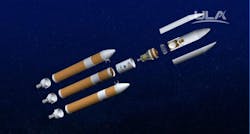ULA Delta IV Heavy rocket to launch NRO spy satellite with ISR electronics and software payload into orbit
NROL-37 will be the 32nd Delta IV mission since the vehicle’s inaugural launch in 2002, and the 10th NRO mission to launch on Delta IV.
The size and weight of the satellite payload drove the need for ULA to employ the largest space launch vehicle in its arsenal, the Delta IV Heavy. Aerojet Rocketdyne engines -- the RS-68A liquid hydrogen-fueled engine -- power the heavy rocket’s propulsion.
Today’s Delta IV Heavy launch includes 26 helium pressurization tanks on the first and second stages of the launch vehicle. They are provided by ARDÉ, a subsidiary of Aerojet Rocketdyne based in New Jersey.
The volume of the helium contained within the pressure vessels is enough to inflate more than 50,000 party balloons.
A fairing with a diameter of five meters will protect the payload during ascent. On 13 May 2016, the payload was mated to the Delta IV Heavy rocket at Cape Canaveral Air Force Station (CCAFS), Fla.
NROL-37 is the 44th NRO launch since 1996 and the 21st from the Cape. It is the sixth NRO mission to launch on a Delta IV Heavy.
ULA reveals the following insights:
Rocket/Payload: A United Launch Alliance Delta IV Heavy will launch the NROL-37 mission for the National Reconnaissance Office (NRO). Date/Site/Launch Time: Thursday, June 9, 2016, from Space Launch Complex (SLC)-37 at Cape Canaveral Air Force Station, Florida. Launch is planned for 3:05 p.m. EDT (pushed off from 1:59 p.m. EDT or 17:59 GMT). Mission Description: The mission will be launched for the National Reconnaissance Office in support of national defense.
You might also like:
Subscribe today to receive all the latest aerospace technology and engineering news, delivered directly to your e-mail inbox twice a week (Tuesdays and Thursdays). Sign upfor your free subscription to the Intelligent Inbox e-newsletter at http://www.intelligent-aerospace.com/subscribe.html.
Connect with Intelligent Aerospace on social media: Twitter (@IntelligentAero), LinkedIn,Google+, and Instagram.
Intelligent Aerospace
Global Aerospace Technology NetworkIntelligent Aerospace, the global aerospace technology network, reports on the latest tools, technologies, and trends of vital importance to aerospace professionals involved in air traffic control, airport operations, satellites and space, and commercial and military avionics on fixed-wing, rotor-wing, and unmanned aircraft throughout the world.




